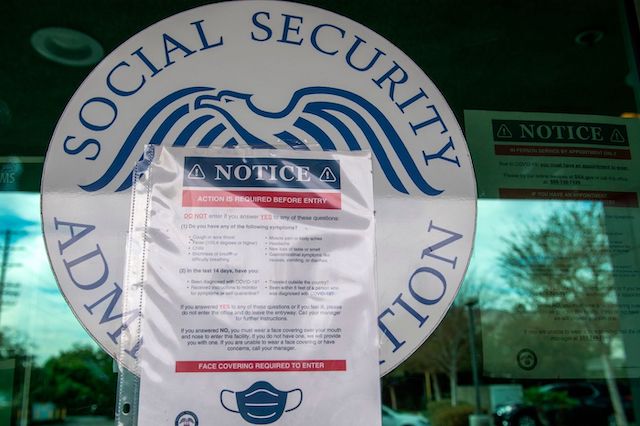
A notice regarding measures in place during the coronavirus pandemic is displayed outside a U.S. Social Security Administration building in November in Burbank, Calif. AFP VIA GETTY IMAGES
Social Security’s trust funds will become unable to pay full benefits starting in 2034, one year earlier than estimated last year, its trustees projected Tuesday, as the COVID-19 pandemic forces a reassessment of the giant federal program’s finances.
The U.S. government also said Medicare’s hospital insurance fund will be depleted by 2026, or at the same time as predicted in 2020. It issued annual trustees reports on both programs Tuesday.
“The pandemic and its economic impact have had an effect on Social Security’s Trust Funds, and the future course of the pandemic is still uncertain,” said the Social Security Administration’s acting commissioner, Kilolo Kijakazi, in a statement.
“Yet, Social Security will continue to play a critical role in the lives of 65 million beneficiaries and 176 million workers and their families during 2021.”
Social Security has two programs, one for retirees and another that provides disability benefits.
The government said the Old-Age and Survivors Insurance Trust Fund will become unable to pay full benefits starting in 2033, a year earlier than projected last year, while the Disability Insurance Trust Fund will become depleted in 2057, or 8 years earlier. Hypothetical combined OASI and DI funds would become unable to pay scheduled benefits on a timely basis in 2034, a year earlier, according to the government.
Senior administration officials told reporters that the U.S. economic recession caused by COVID led to a drop in employment and therefore a decrease in payroll tax revenue, and that accelerates the depletion of Social Security’s reserves.
They also said their latest projections took in other effects of COVID and the recession, such increased death rates, lower birth rates and a decline in immigration.
The annual reports have called for adjustments for years, but lawmakers in Washington have been averse to reducing benefits or hiking taxes.
The latest status updates for the government’s two largest benefit programs come after years of discussion about a retirement crisis in the U.S., driven by people saving too little for their twilight years even as retirements periods are increasing thanks to lengthening life expectancies.
Written by Victor Reklaitis for Market Watch ~ September 1, 2021








